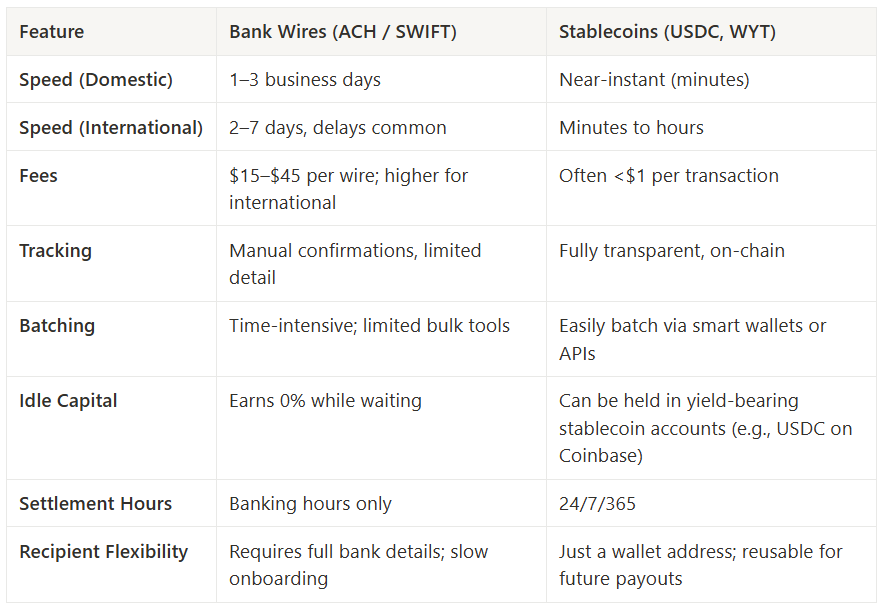Modernizing Investor Management with Stablecoins
Managing investor distributions is a recurring process for private funds, syndicates, and small businesses with outside capital. Traditionally, this process has relied on bank wires and ACH transfers—a system built decades ago for a very different financial environment.
Today, stablecoins offer an increasingly viable alternative, especially for groups looking to reduce fees, improve transparency, and make more efficient use of idle capital.
Cap Table + Distributions: A Broken Process?
Let’s take a typical example: A real estate syndicator or fund manager needs to send distributions to 25 investors. Half are domestic. A few are overseas. The standard process might include:
Exporting cap table data to spreadsheets
Uploading individual wires into a bank portal
Paying $15–$45 per transaction
Waiting 1–3 business days for domestic settlement, and longer for international recipients
Fielding emails about "Did the wire go through?"
For each distribution cycle, this is a manual, expensive, and opaque process that offers no yield or liquidity benefits while cash sits idle during processing.
Why Stablecoins Are Being Considered
Stablecoins like USDC or Wyoming Stable Token (WYT) are digital representations of dollars, backed 1:1 by cash or U.S. Treasury assets. They operate on public blockchains and can be used to send value instantly—without relying on traditional banks or payment rails.
Let’s compare some key differences.
🧾 Bank Wires vs. Stablecoin Payouts
Transparency for Both Sender and Recipient
With wires, the sender sees the money leave, but often doesn’t know when it arrives. The recipient has to manually check their account or email.
Stablecoin transactions, by contrast, are instantly verifiable on-chain. Both parties can view the timestamp, amount, and wallet addresses without intermediaries.
This level of transparency adds a layer of auditability to the cap table—especially when paired with on-chain ownership tokens or smart contracts that represent equity interests.
More Efficient Use of Cash Between Distributions
One often-overlooked benefit of using stablecoins for distributions is the ability to hold idle capital in yield-bearing formats until the moment of transfer.
Instead of sitting in a 0% checking account while awaiting wire execution:
Funds can be held in USDC-backed treasuries (e.g., Circle Yield, Coinbase Prime)
Distributions can be triggered programmatically once calculations are finalized
No settlement delay = no cash drag
For funds or syndicates doing quarterly or monthly distributions, this can meaningfully improve internal IRRs over time.
Considerations Before Transitioning
While stablecoin-based distribution offers real advantages, it’s not plug-and-play. Considerations include:
Investor Education: Not all LPs or stakeholders are familiar with wallets or custody.
Custody & Compliance: Businesses may need to set up secure, auditable processes for holding and transferring digital assets.
Jurisdictional Differences: International regulations and recipient comfort levels vary—especially in highly regulated markets.
For these reasons, some groups begin by offering optional stablecoin payouts, giving investors the choice between wire and digital delivery.
Conclusion
Wires aren’t broken—but they are inefficient. For managers and founders who regularly process distributions or handle complex ownership tables, stablecoins present a more transparent, cost-effective, and operationally flexible model.
They won’t replace traditional finance overnight, but in many cases, they’re already outperforming it.
Ping helps businesses and funds streamline cap table distributions with stablecoins, while staying compliant and easy to use. Whether you're managing 10 investors or 100, our tools can help you reduce friction and move capital faster.

